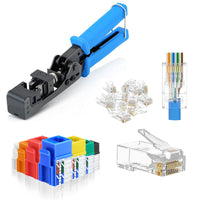A reliable and fast network connection is usually essential for large businesses. The occurrence of the point-to-point connection has contributed a lot to enterprises, ensuring these large corporations can maintain high-speed networks. P2P connections provide secure connectivity that works over large areas, but this kind of connection has its own advantages and disadvantages. In this blog, we will provide a detailed explanation of point-to-point connections, including what the point-to-point connection is, its advantages and disadvantages, and applications. Let’s dive in!
What is Point-to-Point Connection?
A point-to-point connection, also known as a point-to-point link, P2P, private line, or leased line, is a private data connection connecting two points for a secure data transmission. As its name suggests, it is a connection forming a straight-line mode and doesn’t pass through the public network, which avoids hackers or cyber-attacks during operations. It is the simplest form of network communication established by various mediums, including wired links and wireless technologies like Ethernet cables, fiber optic cables, and Wi-Fi. It is a Point-to-point connections are often used for high-bandwidth and low-latency applications, ensuring fast and efficient data transfer.
Pros and Cons of Point-to-Point Connection
- Pros
High Bandwidth and High Speed: A point-to-point connection always provides higher bandwidth and lower latency than other connections that use a shared bandwidth. The public network can be affected by signal disruption, while the P2P connection features a dedicated link for high and stable bandwidth. P2P connection is more ideal for high-speed data transmission and real-time applications than public networks.
Secure Connection: Point-to-point connections provide secure communication between two endpoints. The reduction of intermediate devices largely increases the security of point-to-point connections. It also offers strong authentication measures to ensure unauthorized devices have no access to the connection. Besides, encryption is also critical for P2P connection, which provides additional protection for sensitive information. It is ideal for government agencies and businesses that have sensitive information.
Reliability: Point-to-point connections send data across a dedicated and single path, reducing the chances of packet loss, delays, and interference during transmission. P2P also provides a reliable connection in remote areas.
Simplicity: Point-to-point connection only contains two points, which simplifies the network management process. It will save time to troubleshoot when network errors occur, so it will be easy for users to maintain a stable and clean network connection.
Coverage: Point-to-point connection can cover a large area with stable data transmission.
- Cons
High Cost: Point-to-point connection usually has a high cost as the network grows, the cost of implementing point-to-point connections increases.
Poor Scalability: As networks expand, point-to-point connections are required to establish mass direct connections, which may lead to a complex network topology that is hard to manage. Besides, it may limit the flexibility of the connection to add an additional P2P connection for each new device.
Vulnerability: As the point-to-point connection is established between the two nodes, if there is a node out of order, the whole data transmission will be stopped without any alternative path for data, and the point-to-point connection will fail in this case.
Typical Applications
Telecommunications: In long-distance network communications, point-to-point connections provide a dedicated lease line to transmit data, audio, and video signals from one point to another. For example, the connection between the headquarters office and a remote office. It can also be used for fiber optic links and wireless backhauling.
Internet Service Provision: The ISP provides point-to-point internet for users’ networks. DSL, fiber optic connection, and broadband cable are common types. Besides, Point-to-point wireless internet uses microwave and radio frequencies to connect two distant points rather than physical cabling, providing remote areas with internet access.
Networking: P2P connections provide an essential backbone in networking. For example, it can link two different network devices like computers and switches. P2P is also used in many WAN connections to ensure secure and efficient data transfer.
Control and Management: Point-to-point connection can be used to remote control and monitor. For example, in industrial settings, the point-to-point connection allows for real-time, reliable control and monitoring during operation.
How to Establish a Point-to-Point Connection in Your Network?
To establish a point-to-point connection in a network, it involves establishing a communication link between two single devices. But it differs from wired connection and wireless connection.
In terms of wired connection, the link is the Ethernet cable and fiber optic cable. In the past, the devices could be connected with copper Ethernet cables for short-distance communication. For those long-distance connections, fiber optic cables always play a role in establishing a reliable connection between two devices.
For a wireless connection, you are required to follow the general steps to set up your network:
1. Set the primary computer to be a server computer on the Control Panel of your computer.
2. Set the network and internet connection on the Control Panel. Locate the Wi-Fi connection to check the available Wi-Fi.
3. Add the Wi-Fi and write the name of the network. You must make sure the name is different from other networks that can be detected by your computer.
4. Then, there is a check box for you to set a password for a secure network, or you can also create a network without a password.
5. Set up the network key and let the users know the format and length of the key.
6. Set up the key index if you want to obtain extra security, or it will be 0.
During the establishment, you are supposed to consider the expansion of the network and the change of requirements in the future. And security is always an important factor when establishing a point-to-point connection in a network.
Point-to-Point vs. Multipoint Communication
Point-to-point communication refers to a direct connection established between two points or devices. In contrast, multipoint communication usually occurs in two or more devices. It is the main difference between point-to-point and multipoint communication. In point-to-point communication, there is a dedicated link for the two connected devices with the entire capacity available for the two devices. However, for multipoint communication, the link and capacity are shared among all connected devices, which can lead to potential bandwidth division. In addition, point-to-point communication usually involves only one transmitter and one receiver, but multipoint communication has one transmitter and more receivers. Regarding data security, the point-to-point connection has high security and privacy during data transmission, while multipoint communication is not as secure as point-to-point communication because of more connected devices.

Future of Point-to-Point Connection
If you’re looking for a cost-effective and secure connection for multiple buildings in a large area, point-to-point connection can be your ideal choice. The connection continues to evolve, with significant improvement in higher frequency bands and larger capacity. It can be more cost-effective with reduced energy consumption. Furthermore, to meet future requirements, it is expected to play a more important role in establishing IoT connectivity with smart devices.
For more information on this topic, you can keep up on our blogs. While VCELINK offers general and basic information for our customers and other visitors to the website, it’s not professional advice.






Be the first one to comment.
Leave a comment